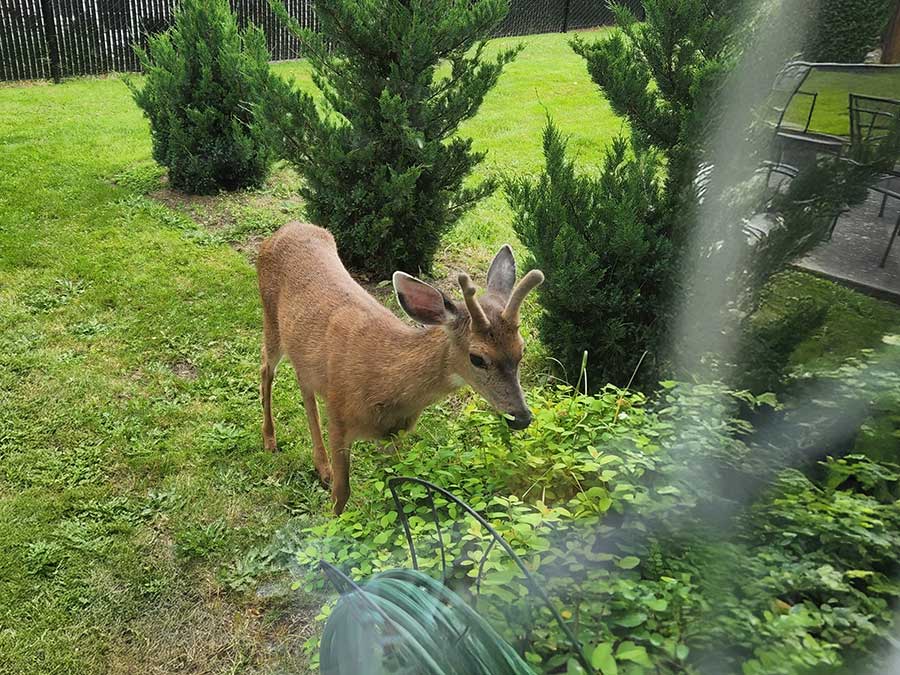
This is a list of some more common deer resistant plants. These plants will usually not be disturbed, but please note that deer vary from location to location and herd to herd, and a very hungry deer may cause damage to most any of these plants.
Most damage done to deer resistant plants occurs within a short time of planting.
Use deer repellents to discourage initial browsing, such as the Deer Gard Electronic Deer Repeller or Fend Off Deer & Rabbit Repellent.
Deer Resistant Perennials
- Achillea ‘Coronation Gold’, ‘Moonshine’
- Agastache
- Amaryllis belladonna – Naked Lady
- Anemone japonica – Japanese Anemone
- Artemesia sp.
- Astilbe sp. – Meadow Sweet
- Ceratostigma plumbaginoides
- Chrysanthemum maximum – Shasta Daisy
- Diascia sp. – Twinspur
- Dicentra sp. – Bleeding Heart
- Digitalis sp. – Foxglove
- Erigeron sp.
- Euphorbia sp.
- Ferns – most
- Gaillardia sp.
- Grasses
- Helichrysum petiolare – Licorice Plant
- Helleborus sp.
- Iris – most
- Kniphofia uvaria
- Lantana montevidensis – may eat flowers
- Lamium maculatum – Dead Nettle
- Lavandula sp. – Lavender
- Liriope sp. – Lily Turf
- Lychnis coronaria
- Nepeta sp.
- Omphalodes cappadocica – Navelwort
- Ophiopogon sp.
- Origanum sp.
- Perovskia – Russian Sage
- Phlomis fruiticosa
- Phlomis lanata
- Phormium – New Zealand Flax
- Phygelius – Cape Fuchsia
- Romneya coulteri – Matilija Poppy
- Rosmarimus – Rosemary
- Rudbeckia sp.
- Salvia – Sage – most
- Santolina sp.
- Senecio cineraria – Dusty Miller
- Stachys byzantina – Lamb’s Ears
- Tagetes lemmonii
- Teucrium sp. – Germander
- Thymus sp. – Thyme
- Tulbaghia
Deer Resistant Shrubs
- Adenanthos drummondii
- Azalea Southern Indica – can be eaten
- Bamboo
- Berberis sp. – Barberry
- Buxus sp. – Boxwood
- Callistemon sp. – Bottlebrush
- Calluna – Scotch Heather
- Choisya ternata – Mexican Orange
- Clivia miniata
- Coleonema pulchrum – Pink Breath of Heaven
- Conifers – most
- Cordyline sp.
- Correa pulchella – Australian Fuchsia
- Daphne odora – Winter Daphne
- Dietes bicolor
- Dietes vegeta
- Echium sp.
- Eleagnus sp.
- Erica – Heath
- Fremontodendron sp. – Flannel Bush
- Grevillea sp.
- Hakea sp.
- Ilex sp. – Holly
- Juniperus sp. – Juniper
- Laurus nobilis – Sweet Bay
- Leonotis sp.
- Leptospermum sp. – Tea Tree
- Mahonia sp.
- Myoporum laetum
- Myrtus communis – Myrtle
- Nerium oleander – Oleander
- Olea europaea – Olive
- Ozothamnus
- Pieris – Lily of the Valley Shrub
- Podocarpus
- Rhododendron – can be eaten
- Rubus pentalobus (R. calycinoides)
- Sarcococca
- Strelitzia – Bird of Paradise
- Westringia sp.
- Yucca
- Zauschneria – California fuchsia
Deer Resistant Annuals
- Chrysanthemum paludosum
- Lobularia maritima – Sweet Alyssum
- Myosotis – Forget Me Not
- Nicotiana
- Primula obconica – sometimes
- Vinca rosea
- Zinnia
Deer Resistant Trees
- Agonis flexuosa – Peppermint Tree
- Cedrus – Cedar
- Eucalyptus sp.
- Grevillea robusta – Silk Oak
- Koelreutia
- Magnolia
- Melaleuca sp.
- Metrosideros
- Myoporum laetum
- Pistacia chinensis – Chinese Pistache
- Quercus – Oak – protect while young
- Pinus – Pine
Deer Resistant Vines
- Clematis armandii
- Clematis hybrids
- Ficus pumila – Creeping Fig
- Gelsemium sempervirens – Carolina Jessamine
- Hardenbergia
- Jasminum polyanthum
- Solanum jasminoides – Potato Vine
- Wisteria sp.
Deer Resistant Ground Covers
- Ajuga – Carpet Bugle
- Cerastium tomentosum – Snow-in-Summer
- Chamaemelum nobile – Chamomile
- Galium odoratum – Sweet Woodruff
- Gazania
- Hypericum – St. Johnswort
- Ice Plant
- Laurentia fluviatilis – Blue Star Creeper
- Mentha pulegium – Pennyroyal
- Mentha requienii – Corsican Mint
- Myoporum parvifolium
- Osteospermum fruticosum
- Polygonum – Knotweed
- Potentillata bernaemontanii
- Rosmarinus – Rosemary
- Soleirolia soleirolii – Baby’s Tears
- Thymus sp. – Thyme
- Vinca sp. – Periwinkle






